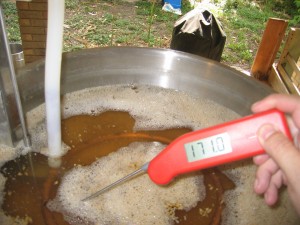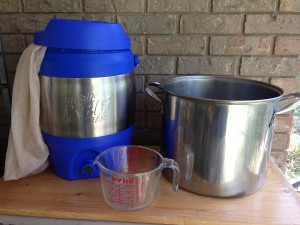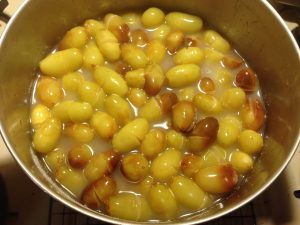 One of the most-asked questions on homebrewing forums is, “Should I dump it?” And, we’ve all likely been there. Something seems wrong with a batch and you are starting to fear that the worst has happened. With experience, you can learn which warning signs point to real trouble and which do not. For new brewers, however, unusual aromas, sights, or flavors can cause a panic. Here is a quick rundown of situations that lead brewers to ask this question, and what they should do. [Read more…]
One of the most-asked questions on homebrewing forums is, “Should I dump it?” And, we’ve all likely been there. Something seems wrong with a batch and you are starting to fear that the worst has happened. With experience, you can learn which warning signs point to real trouble and which do not. For new brewers, however, unusual aromas, sights, or flavors can cause a panic. Here is a quick rundown of situations that lead brewers to ask this question, and what they should do. [Read more…]
Should I Dump It?
A Surefire Way to Improve Your Beers . . . And Why You Will Ignore This Advice
 I once met a fellow brewer who had built his own RIMS system. He had two temperature probes in his mash vessel and had fiddled with the engineering of the heating loop and wort return. He had also tweaked his process, varying how the wort was heated, his pump speed, etc., and finally arrived at a point that he was proud of. He could hold his mash temperatures steady, within only 0.5 °F (~0.25 °C) over time or between different places in the mash (except for inside the heating loop, obviously). He could program virtually any step mash into his controller and the rig would carry it out. He was very proud of his accomplishment (as he should have been) and he offered me one of his beers. It was contaminated. [Read more…]
I once met a fellow brewer who had built his own RIMS system. He had two temperature probes in his mash vessel and had fiddled with the engineering of the heating loop and wort return. He had also tweaked his process, varying how the wort was heated, his pump speed, etc., and finally arrived at a point that he was proud of. He could hold his mash temperatures steady, within only 0.5 °F (~0.25 °C) over time or between different places in the mash (except for inside the heating loop, obviously). He could program virtually any step mash into his controller and the rig would carry it out. He was very proud of his accomplishment (as he should have been) and he offered me one of his beers. It was contaminated. [Read more…]
Time to Get Happy
OK, it’s time for me to get happy. And to do so, I’m going to brew another version of one of my favorite beers — Ancient Sumerian Happy Juice. Several years ago, I read the English translation of the poem Hymn to Ninkasi. This poem praises the goddess Ninkasi, who the ancient Sumerians believed watched over beer production. From the poem, I came up with a “beer” recipe. The beverage contains honey and fruits, as well as grains, so it’s really a hybrid beer, wine, and mead. The basic idea was that dates were crushed and made into wine. Barley was milled and mixed with honey and baked into bread, which the poem called bappir. Malted grains were then mashed along with the bread. The wort from this was boiled and then cooled and the fermenting date wine was added to it. I used some smoked malt in the recipe as I figured that ancient malting techniques may have yielded malt tainted with smoke. [Read more…]
20 Brewing Questions
So you think you know brewing, huh? Well step up to the plate and try to answer these 20 brewing questions. If you can pick the right answers from the wrong answers, the doubly wrong answers, and the answers that are so wrong that they just might be right, you will have our undying respect. This quiz is meant to be challenging, but also fun. And, given that you’ll score it yourself, you can still score 100% no matter what you answer (you know, like most online quizzes). If you’re brave, post your answers — that you gave without Googling — in the comments section. I’ll post the answer key with explanations of everything — and hopefully better jokes — on Thursday. So, grab your #2 pencil, then set it back down because you shouldn’t draw on your computer screen and . . . begin the quiz! [Read more…]
Grapefruit Juice Pale Ale
One thing that attracts me to “West Coast” pale ales and IPAs is the citrus character of their hops. I remember brewing my first pale ale with Amarillo back in the day, and I was amazed by the amount of grapefruit flavor and aroma coming out of my pint glass. In order to chase that fruit character, I decided to play with some juice.
As Chris noted in an earlier story on brewing fruit beers, you can use peel, flesh, juice or extract from fruit to achieve a fruity flavor. Back in 2014, I brewed a pineapple saison using a quart of frozen pineapple juice added at the end of the boil. This was inspired by an interview with homebrewers Brook Baber and David Bauter on Basic Brewing Radio about their method of brewing graf, a fictional beverage envisioned by Stephen King’s “The Dark Tower” series. Brook and David froze fruit juice in plastic bags and added it to the end of the boil to help jump start the chilling process. The technique worked well for my saison, so I decided to adopt it for my grapefruit pale ale. [Read more…]
Sorghum Syrup Belgian-Style Ale
Sweet sorghum syrup is tasty on pancakes, and it’s also a tasty addition to a Belgian-style ale. Its flavor is much like molasses. However, how it’s made is more like maple syrup.
Every fall, participants in the Cane Hill Harvest Festival in Cane Hill, Arkansas, take sorghum cane grown on the grounds of historic Cane Hill College and turn it into dark, sticky deliciousness. The locals just call it “sorghum,” but sorghum cane is different from sorghum grain, which is used to brew gluten-free beers. And although some people call the end product “sorghum molasses,” it’s not really molasses. Molasses is a by-product of turning sugar cane and sugar beets into granulated sugar. [Read more…]
Partial Mashing Positives
 Like most homebrewers, I started out using the standard “malt extract with steeping grains” method of homebrewing. I can remember making a “pale ale” with two cans of liquid malt extract, a pound of crystal malt, and 2 oz. (60 g) of Cascade hops.
Like most homebrewers, I started out using the standard “malt extract with steeping grains” method of homebrewing. I can remember making a “pale ale” with two cans of liquid malt extract, a pound of crystal malt, and 2 oz. (60 g) of Cascade hops.
Later, I switched to all-grain brewing and was a bit of a purist for many years, only brewing all-grain batches. After all, my beers got markedly better when I switched to all-grain, why go back to an inferior method? Years later, I realized that it wasn’t the switch to all-grain that made better beers, it was all the other things I started doing at that same time. For example, I started making yeast starters. I started to evaluate my brewing ingredients and not brewing with stale malt or cheesy hops. And I started learning more about the science of brewing. [Read more…]
Blackberry “Pilsner”
This past summer, I asked my wife, Susan, what I should brew next. She suggested a blackberry Pilsner. I had never heard of such a thing, but in the interest of keeping her happy and tolerant of my hobby/occupation, I decided to give it a go.
I put “Pilsner” in quotation marks in the title of this recipe for a couple of reasons. First of all, those who abide by the Reinheitsgebot – the beer purity law – would cringe at the thought of adding fruit to this classic German style. Blackberries definitely fall outside the malt, hops, water and yeast list. Second, Pilsners are traditionally lagered to brew a beer of clean profile with no fruity yeast characteristics. It didn’t make sense to me to go to the trouble of fermenting cold to avoid fruity flavors to then add some fruit afterwards. So, I fermented this beer with lager yeast at ale fermentation temperatures. [Read more…]
Tweaking Your Hop Schedule (Part II)
 As discussed in the first installment of this article, substituting a lesser weight of higher alpha hops for a higher weight of lower alpha hops is one way to tweak the hop profile of your beer. In that case, you could achieve the same IBU rating, but with less plant material added to your kettle. This decreases the volume of beer lost to trub and hop debris in the bottom of the kettle. And, in the case of very hoppy beers, may lower the amount of astringency contributed by the hops (because hops contain tannins as most plant material does). There are also ways to tweak your late hop profile to get more “bang for your buck” from your hops. [Read more…]
As discussed in the first installment of this article, substituting a lesser weight of higher alpha hops for a higher weight of lower alpha hops is one way to tweak the hop profile of your beer. In that case, you could achieve the same IBU rating, but with less plant material added to your kettle. This decreases the volume of beer lost to trub and hop debris in the bottom of the kettle. And, in the case of very hoppy beers, may lower the amount of astringency contributed by the hops (because hops contain tannins as most plant material does). There are also ways to tweak your late hop profile to get more “bang for your buck” from your hops. [Read more…]
Tweaking Your Hop Schedule
 We’ve all been there. You’re all set to brew your favorite IPA, hoppy porter, or other hoppy beer, but you can’t get your hands on the hop varieties you used last time. Or maybe you just want to change things up and examine your hop schedules to see if you make changes. What do you do? Here are some ideas.
We’ve all been there. You’re all set to brew your favorite IPA, hoppy porter, or other hoppy beer, but you can’t get your hands on the hop varieties you used last time. Or maybe you just want to change things up and examine your hop schedules to see if you make changes. What do you do? Here are some ideas.
In the case of replacing a hop variety, the easiest thing to do would be to find a hop variety that is similar and use that instead. And of course, numerous websites have lists of hop strains and their possible substitutions. The only problem with that is that every hop variety really does have different characteristics, so a one-for-one hop substitution is always going to make the beer taste different. In a beer that isn’t hop forward, and that contains lots of malt (or other) character, the difference may be small, perhaps not even noticeable. However, in a beer in which the focus is on the hops, you will always be able to tell. [Read more…]





Recent Comments